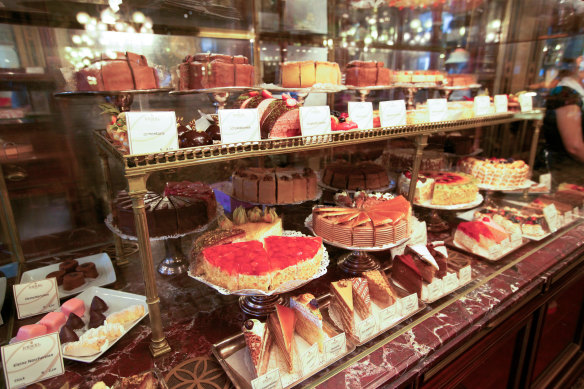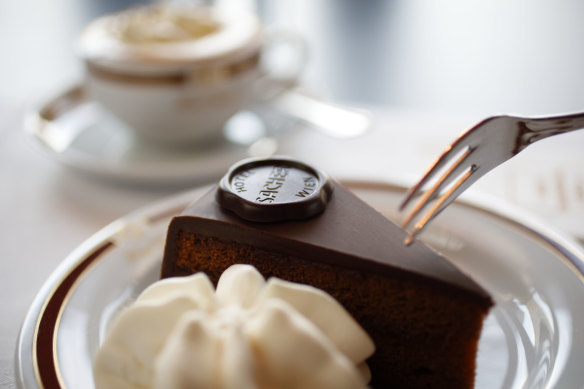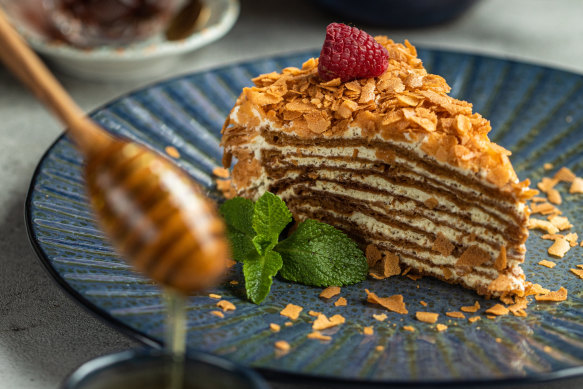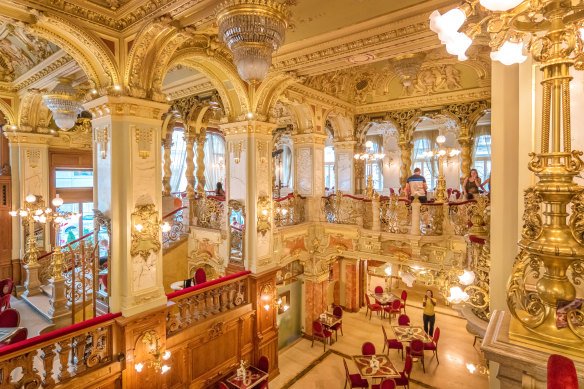Forget banh mi and ramen: When I arrive at a destination, this is what I crave
By Lee Tulloch
My guiding principle when I’m in an unfamiliar place and I need to get grounded fast is simple.
Find the cake shop.
Bakeries, boulangeries, patisseries, pasticcerie, konditoreien – whatever they are called in each country – are happy places where locals chatter away as they line up to buy their daily bread (and something for dessert) and impatient children gather for their after-school treats.

Demel Restaurant, Coffee Shop and Bakery, Vienna.Credit: Alamy
Some just sell simple baked goods; others display cascades of creamy deliciousness, gateaux as beautifully constructed as buildings. Some have nothing more than counters from where you take away your purchases in paper bags; others have table service and waiters in white aprons.
Just as gourmands might seek out the best banh mi in Vietnam or ramen in Japan, my mission is to hunt down the iconic cakes that make a place tick. And luckily, they are easily found. Just follow the crumbs.
A few months ago, I was in Trieste, a popular cruise port on the Adriatic due to its proximity to Venice. It’s a beautiful, small Italian city that was once part of the Austro-Hungarian Empire and is almost entirely surrounded by Slovenia.
It’s also Italy’s coffee capital, the home of Illy coffee. The Triestino apparently drink twice as much coffee as other Italians, and the city boasts many gorgeous 19th-century coffee houses. It’s a kind of Vienna on the sea.
Having barely a couple of hours in port after a cruise excursion, I naturally headed straight for the famous cake shop, Pasticceria La Bomboniera, which dates from 1836.
While the other passengers traipsed around the city’s seven hills, I made the better choice, sitting in the weak sun sampling various Austro-Hungarian delicacies from glass display shelves laden with traditional cakes such as Presnitz Strudel or the rolled cake Putizza. So many cakes, so little time.
Speaking of Vienna, it’s part of the world cake pilgrimage to head to the Sacher Hotel for a slice of its famous sacher-torte – best experienced in the turn-of-the-century Blaue Bar with a cup of cafe mit schlag (coffee with whipped cream).

When in Vienna, sacher-torte is a must.
Vienna, to my mind, is Cake Central. Its multiple coffee houses and konditoreien can send you into a sugar coma just perusing the menus.
Although tourists can make it unpleasantly crowded at times, the opulent Demel is the place where Empress Elisabeth bought her candied violets (I still have a jar from there). It’s famous for its “heirloom” cakes, such as marmorgugelhupf, a marble Bundt cake, and the fragilité schaumrolle, a cream-filled horn of pastry.

Budapest’s Dobos torte.Credit: iStock
If you find the Sacher torte too dry, I suggest trying Demel’s Anna cake – a moist chocolate gateau layered with Paris cream, nougat and orange liqueur. Sublime.
In Budapest, another great cake city, the pilgrimage is to the New York Cafe – now part of the Anantara Palace Hotel – for a slice of Dobos torte, a roll of sponge filled with cream and fruit. Built in 1894 for the New York Insurance Company (hence its confusing name), its baroque decor is so gaudy it looks like Bavarian “Mad King” Ludwig II was its architect. You won’t find a more extravagant place to eat a piece of cake anywhere.

New York Cafe in Budapest: You won’t find a more extravagant place to eat cake.Credit: Alamy
In Sicily, there’s cassata and all kinds of tangy lemon cakes, and in France, Opera cakes and Paris-Brests can set off heart palpitations. The Japanese go mad for mochi (sweet rice cakes) and the German-origin Baumkuchen (tree cake) made from 20 layers of batter that when sliced look like tree rings.
In Lisbon, I’m off the plane and straight on the train to Belem, the home of the pastel de nata, the humble egg custard tart. The Catholic monks in the Jeronimos Monastery first made them from leftover egg yolks after the whites were used to starch their clothes.
I’ve always loved these tarts, but you don’t really know them unless you taste the original recipe from Fabrica de Pasteis de Belem, established in 1837. The cinnamon-sprinkled morsels are so delicious it’s worth the long wait in line, and they’re so beautifully wrapped it feels like you’re giving yourself a present, which you are.
In the end, though, I’m happy for simple pleasures – a warm cinnamon bun in a bag eaten on a stool at a market like Torvehallerne in Copenhagen or Helsinki’s Old Market Hall.
Frankly, I elevate a warm cinnamon bun over all other foods – followed by a flaky, caramel apple turnover the way the French do it.
Besides, a little sugar hit always helps with jet lag. It’s medicinal.
That’s my excuse, anyway.
Sign up for the Traveller Deals newsletter
Get exclusive travel deals delivered straight to your inbox. Sign up now.